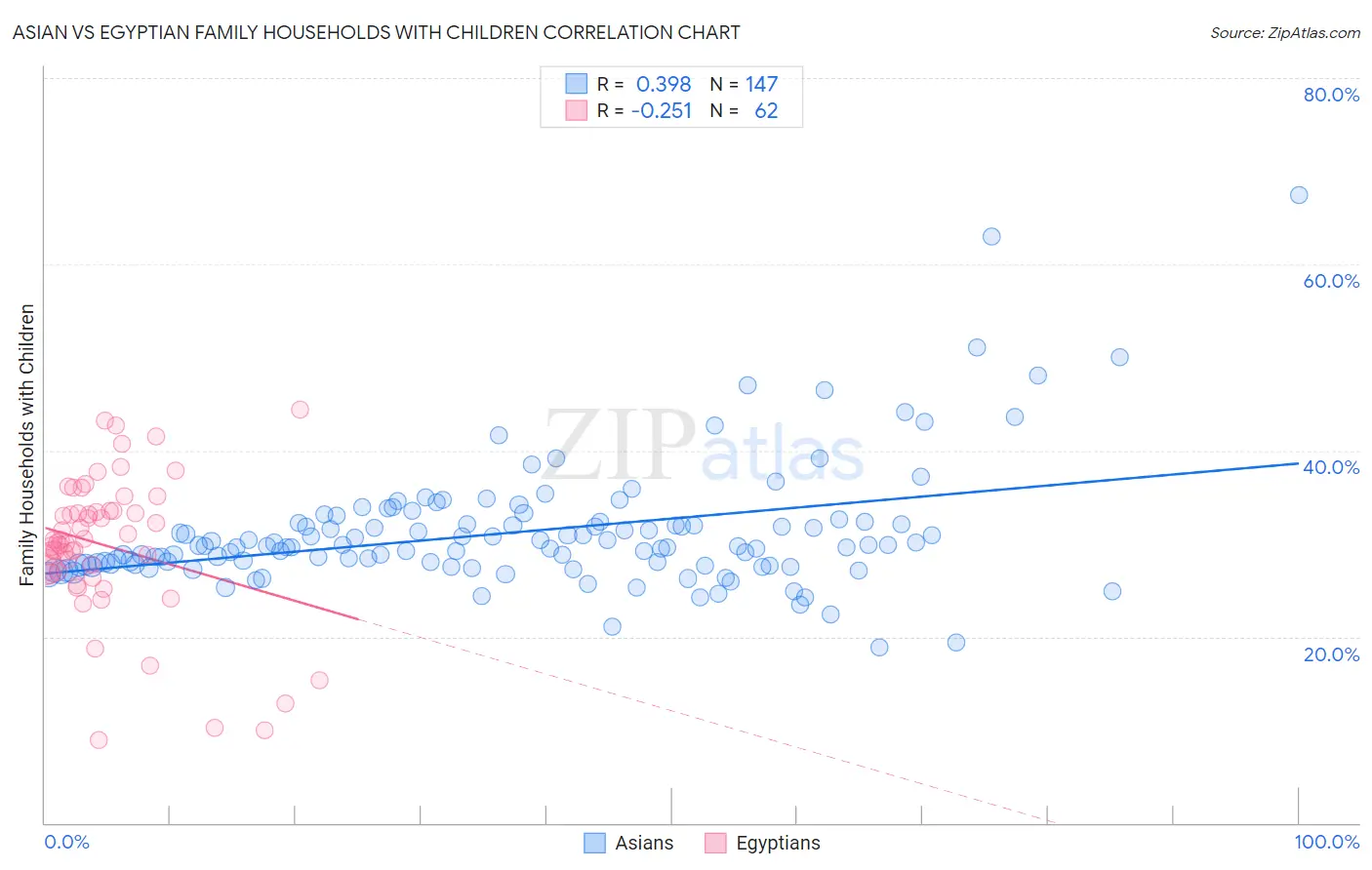Asian vs Egyptian Family Households with Children
COMPARE
Asian
Egyptian
Family Households with Children
Family Households with Children Comparison
Asians
Egyptians
29.1%
FAMILY HOUSEHOLDS WITH CHILDREN
100.0/ 100
METRIC RATING
43rd/ 347
METRIC RANK
28.6%
FAMILY HOUSEHOLDS WITH CHILDREN
99.9/ 100
METRIC RATING
62nd/ 347
METRIC RANK
Asian vs Egyptian Family Households with Children Correlation Chart
The statistical analysis conducted on geographies consisting of 549,945,498 people shows a mild positive correlation between the proportion of Asians and percentage of family households with children in the United States with a correlation coefficient (R) of 0.398 and weighted average of 29.1%. Similarly, the statistical analysis conducted on geographies consisting of 276,723,802 people shows a weak negative correlation between the proportion of Egyptians and percentage of family households with children in the United States with a correlation coefficient (R) of -0.251 and weighted average of 28.6%, a difference of 1.7%.

Family Households with Children Correlation Summary
| Measurement | Asian | Egyptian |
| Minimum | 18.8% | 8.8% |
| Maximum | 67.5% | 44.4% |
| Range | 48.7% | 35.6% |
| Mean | 31.2% | 29.8% |
| Median | 29.7% | 30.3% |
| Interquartile 25% (IQ1) | 27.7% | 27.0% |
| Interquartile 75% (IQ3) | 32.2% | 33.5% |
| Interquartile Range (IQR) | 4.5% | 6.5% |
| Standard Deviation (Sample) | 6.7% | 7.7% |
| Standard Deviation (Population) | 6.7% | 7.6% |
Demographics Similar to Asians and Egyptians by Family Households with Children
In terms of family households with children, the demographic groups most similar to Asians are Immigrants from Taiwan (29.0%, a difference of 0.040%), Fijian (29.0%, a difference of 0.10%), Immigrants from Philippines (29.0%, a difference of 0.18%), Spanish American Indian (29.1%, a difference of 0.19%), and Peruvian (29.0%, a difference of 0.19%). Similarly, the demographic groups most similar to Egyptians are Immigrants from Ghana (28.6%, a difference of 0.0%), Hmong (28.6%, a difference of 0.080%), Immigrants from Nigeria (28.6%, a difference of 0.13%), Hawaiian (28.7%, a difference of 0.46%), and Danish (28.7%, a difference of 0.61%).
| Demographics | Rating | Rank | Family Households with Children |
| Spanish American Indians | 100.0 /100 | #42 | Exceptional 29.1% |
| Asians | 100.0 /100 | #43 | Exceptional 29.1% |
| Immigrants | Taiwan | 100.0 /100 | #44 | Exceptional 29.0% |
| Fijians | 100.0 /100 | #45 | Exceptional 29.0% |
| Immigrants | Philippines | 100.0 /100 | #46 | Exceptional 29.0% |
| Peruvians | 100.0 /100 | #47 | Exceptional 29.0% |
| Apache | 100.0 /100 | #48 | Exceptional 29.0% |
| Jordanians | 100.0 /100 | #49 | Exceptional 29.0% |
| Immigrants | Immigrants | 100.0 /100 | #50 | Exceptional 28.9% |
| Immigrants | Peru | 100.0 /100 | #51 | Exceptional 28.9% |
| Guatemalans | 100.0 /100 | #52 | Exceptional 28.9% |
| Immigrants | Cambodia | 100.0 /100 | #53 | Exceptional 28.9% |
| Sierra Leoneans | 100.0 /100 | #54 | Exceptional 28.9% |
| Immigrants | Asia | 100.0 /100 | #55 | Exceptional 28.8% |
| Immigrants | Guatemala | 100.0 /100 | #56 | Exceptional 28.8% |
| Danes | 100.0 /100 | #57 | Exceptional 28.7% |
| Hawaiians | 100.0 /100 | #58 | Exceptional 28.7% |
| Immigrants | Nigeria | 100.0 /100 | #59 | Exceptional 28.6% |
| Hmong | 99.9 /100 | #60 | Exceptional 28.6% |
| Immigrants | Ghana | 99.9 /100 | #61 | Exceptional 28.6% |
| Egyptians | 99.9 /100 | #62 | Exceptional 28.6% |